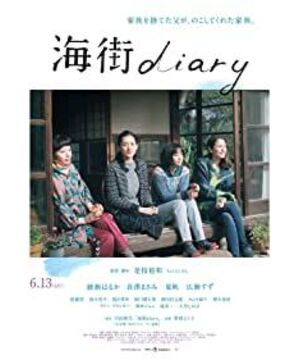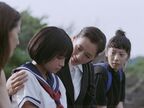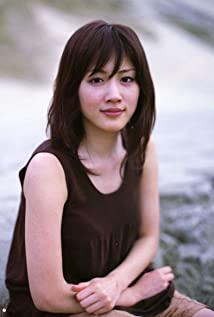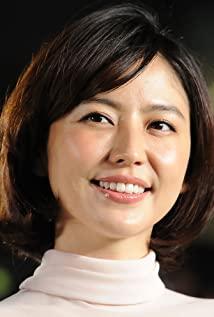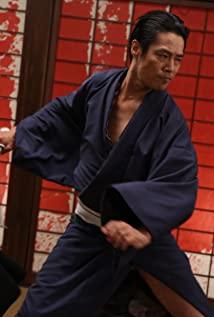It is also mentioned intentionally or unintentionally in the film. Fortunately, she is very much like grandma. She has her own obsession with the old house, the courtyard, and the plum tree. The plum tree in the courtyard was planted by their grandmother for fifty-five years. In winter, I took care of the garden and watered the flowers and plants. The dry plum trees were mixed with yellow daffodils, golden octagonal plates or Nantian bamboo (Judging from the luck of going home one night to pick the Nantian bamboo red fruit), She and her sisters learned from the grandmother’s catchphrase, saying that plum trees, “It takes a lot of effort to remove insects and disinfect, living things.” However, she is still willing to spend this effort to maintain it every year, full of expectation, see Plum blossoms, pick plums, and make plum wine. Unfortunately, there are shots of picking plums and making plum wine in the film, but there are no shots of plum blossoms. It was from the interview with Hirokazu Ke that I realized that the plum tree was transplanted for the purpose of making a movie. In the interview, it was written that the director visited the old house a few months after the completion of the film and saw the white plum blossoms blooming in the courtyard. With plum blossoms and without plum blossoms, the artistic conception should be different. If plum blossoms are shot in the movie, I think the night when the four sisters watch the plum trees in the attic window will be more meaningful, and the feeling of the four seasons in the film will be more intense. Regarding plum blossoms, Inoue Yasushi also wrote that plum blossoms make people feel like waiting for spring. He wrote that he was in the Izu peninsula when he was young, and he had many plum trees in his hometown's garden. Baiying was bloomed in the early spring. Perhaps he was familiar with plum trees when he was a child, and he still loved plum blossoms when he was older. Later he wrote: "The plum trees in my hometown are all withered and old, but the only white plum next to the Tokyo study is still young, so the flower is pure white. The plum tree grows hard and small buds prematurely. Bud, there are no flowers in this season. It is at this time when the flowers are not yet in bloom, naturally cultivate a mood of looking forward to the spring. The yellow flowers of narcissus and the safflower of camellia are probably one of the few flowers in this season. "I think I've had such a feeling fortunately. Love is the result of getting along.
Li Ciming said, “One year of spring, only the plum and willow have the deepest meaning. When the warbler is blooming, the spring has faded." I wanted to change the warbler to cherry blossoms. After Mei Xie Liu Nong, it was when the cherry blossoms were blooming in early and mid-April. The cherry blossoms have bloomed, and spring has passed. In the strong spring of April, although there is no renewal, it is still very happy. Spring is always full of joy and joy of life. In the movie, during the ride in the cherry blossom tunnel, Xiaoling is really beautiful, healthy, youthful, and full of vitality. The viewers are moved by such vitality and beauty, as well as the power of life, so that tears will fill their eyes without knowing it. Later, when the four sisters set off the fireworks, they were also moved by the same. From the perspective of phenology, in the movie, after the cherry blossom carnival, it is the quiet rainy season in May and June, with hydrangea blooming in the rain. In front of the old house, clusters of green leaves were blooming with snowball-like flowers. When it rained, the sound of dripping rain could be heard, and the old house revealed the smell of quietness. In order to conform to the seasonal life, there is also a hydrangea inserted in the flower vessel in the foyer of the old house. So I can understand Xing’s dedication and protection of the old house, and it also resonates (the ancestral house in the mountains of my hometown is still there, although it is very old, I will go back to live in the mountains for a period of time every year), and I can rely on my mind to have this. What a blessing in this place, let alone my sisters. If the cherry blossoms can represent the youth of Xiaoling, the hydrangea can represent the maturity and stability of Kada Yuki. Putting the characters in the corresponding plant environment may not be deliberately arranged by the director, but accidental. In short, because of the existence of such characters, traditional and ancient things will not disappear, such as old plum trees, plum wine made from plum picking every year, light pickles, hagi cakes, sardine sashimi, fried horse mackerel . Switching to China is the Qingming cakes and Qingming groups, the rice dumplings for the Dragon Boat Festival, the moon cakes for the Mid-Autumn Festival, the mochi for the winter solstice, the rice cakes and dumplings for the Spring Festival, and the dumplings for the Lantern Festival. Of course, there are also a series of plants. The feeling of being rich and living in harmony with nature. Fortunately, it can be said to be a kind of "old man". During the interview, Hirokazu Ke also admitted that he was an "old man". He was completely inaccessible to books that were not on paper. He would print out any electronic files in China. This kind of place is really enjoyable. Sometimes, old people are as precious as old things, like that old plum tree.
Fortunately, I also liked the scene of sweeping the grave with my mother. Hydrangeas were planted around the cemetery. Just after a rainy season, the hydrangeas were soggy, the trees were fresh and verdant, and the scenery was clear and clear. There were still people coming to the temple from time to time along the way. The bell sounded leisurely. Having heard such a leisurely and peaceful bell together, any kind of heart disease will clear up. Mom said, I haven't experienced the rainy season for many years. Fortunately, there is no rainy season in Hokkaido. Yes. Mom then said that after making plum wine, I will feel, ah, summer is here. Fortunately, I went to get my mother the plum wine. Otake Shinobu reminded her daughter very gently: "It's very slippery over there, be careful." I really like this conversation. In such small and seasonal homely words, the mother-daughter relationship has also been reconciled. It's really touching. The relationship between mother and daughter is very wonderful. The older you get, you will feel your mother’s goodness. After you become a mother, you can better understand the mother’s tenderness. When I watched this period, my eyes were wet and my sense of substitution was particularly strong. As a southerner living in the north, even the nostalgic memory of Mei Yu was awakened.
The original author Yoshida Akiu originally asked to be Director Eddy to pay attention to the transition of the four seasons when making movies. It's Hirokazu Kee doing a good job. Cherry blossoms, rainy seasons, hydrangea, then plums are ripe, pick plums, make plum wine, summer is here, cicadas are screaming, and the crape myrtle blossoms are gradually blooming. Phenology has been reincarnated for another year, and life and death have also reincarnated twice. The movie begins at the funeral and ends at the funeral. After the funeral at the end of the film, several people stood under a beautiful branch of the crape myrtle flower and talked. There are also clusters of crape myrtle flowers far behind. They talk about human life at the last moment, still want to see beautiful things and be happy about them. In this way, one of the true meanings of life was spoken indifferently. While listening to their conversation, the third sister Qianjia was playing with a crape myrtle flower in her hand, echoing the crape myrtle flower after the film's opening funeral. The funeral at the beginning of the film was the time when the crape myrtle blossoms flourished (the time of "Non-Stop Walking" happened at the same time). After the funeral, when Asano Suzu was sitting in front of the train station with her eldest sister Xing and second sister Kanao, the third sister Qianjia was standing on the side, playing with a crape myrtle flower. When the train was moving forward, Xiaoling followed the train passionately, and Kazuki's sweet crape myrtle appeared on the platform.
The character Qianjia is really simple, cute, funny and enthusiastic. The little girl Ling came here for the first time. She helped carry the luggage, tidy the room, and take care of everything. When the eldest sister and the second sister quarreled, she was always on the sidelines and diverted the subject. Regarding the second sister of Nagasawa Masami, the initial feeling is that this character lives a bit confused, likes to drink, and asks for beer when he arrives in a new place, beautiful and chaotic. Gradually, she will find that this person is also quite cute, and later her character has also grown, probably thanks to the acquaintance of Ryo Kase. Some people need to know the right people will slowly grow and mature. I felt that Kase Ryo's temperament in the film even smelled of Kasato, calmly and slowly.
At the end of the film, watching the black backs of the four sisters walking on the beach, I really hope that they are real, living, and living together like this forever. I really don't want them to disperse and leave the old house, courtyard and plum trees. The changes in the family are indeed sad, so sometimes I really don't want to face the changes. I really hope that they can stand in place like that plum tree, circulating in the four seasons.
View more about Our Little Sister reviews


